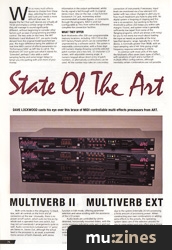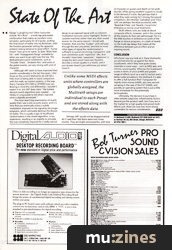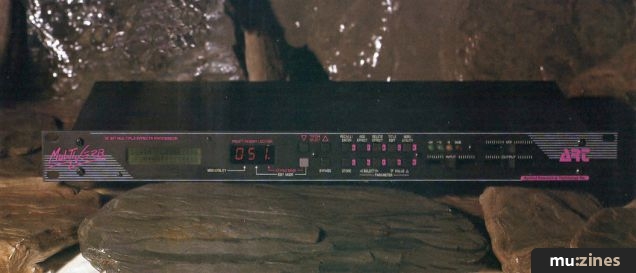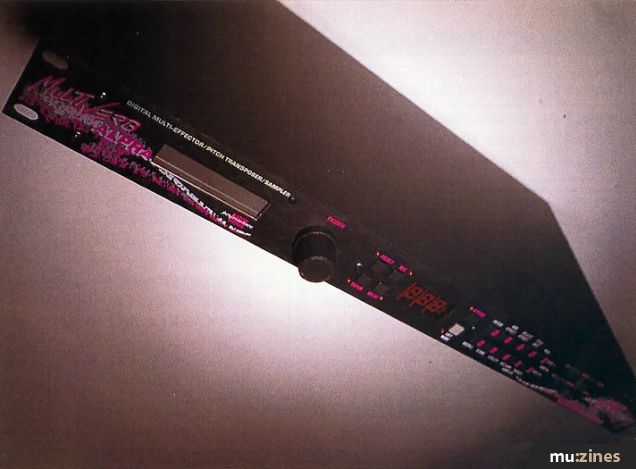Magazine Archive
Home -> Magazines -> Issues -> Articles in this issue -> View
Start of the ART | |
Multiverb II Multiverb EXTArticle from Sound On Sound, March 1990 | |
Dave Lockwood casts his eye over this brace of MIDI controllable multi-effects processors from ART.

With so many multi-effects devices to choose from these days, selecting the one that best suits your needs is more difficult than ever, for despite the fact that such devices are virtually all 16-bit and employ a similar range of effects, they still manage to sound significantly different, without beginning to consider other factors such as ease of programming and MIDI control. The two units on test here, the ART Multiverb II and Multiverb EXT, are quite closely derived from the original model launched last year, the major difference being the addition of real-time MIDI control of effects parameters (or 'Performance MIDI' as ART like to call it). The Multiverb EXT (not quite sure what it stands for, 'Extended' perhaps?) also adds a useful sampling facility and some longer delays to tempt you into parting with a bit more of your money.
Both units reside in the obligatory 1U black box, with all controls on the front and all connectors at the rear. Unusually, there is no power on/off switch, which suits me fine as my whole rack is operated from one switch, but may not suit everybody's arrangements quite so well. Audio connections (unbalanced ¼" jacks) are Stereo In, Stereo Out, although the actual feed to the processor is, as usual, a summed mono version of both channels, with stereo information in the output synthesized, whilst the dry signal is fed through with its original stereo intact. Also on the rear, a dual function footswitch (¼" jack, momentary action recommended) activates Bypass, or increments through the programs. MIDI In and Out (configurable as Thru from within the software) complete the connection facilities.
WHAT THEY OFFER
Both Multiverbs offer 200 user-programmable memory locations, including 100 (110 on the EXT) factory Presets which can be overwritten if unprotected by a software switch. The system is reasonably communicative, with a three-digit LED numeric display showing currently selected patch number and a two-line, 32-character LCD screen, with adjustable viewing angle. A numeric keypad allows direct entry of patch numbers, or alternatively scroll buttons can be used. All the number keys take on a secondary function in Edit mode, offering parameter selection and value scrolling with the assistance of the LCD screen.
Audio levels are controlled by centre-detented, horizontally mounted sliders, with the centre positions indicating unity gain in and out, and 50/50 mix. A wide range of input levels can be accommodated, from -20 to +16dBv; a wide enough sensitivity, combined with a 1Mohm input impedance, to allow direct connection of instruments if necessary. Input levels are monitored via a four-element LED ladder with two colour changes to alert you to how much headroom you have to play with. No digital system is forgiving of clipping and this one is no exception, but working to the first threshold (a yellow LED) keeps you within safe margins I found, and system noise is generally sufficiently low (apart from some of the flanging programs, which are always a bit noisy) for you to not worry too much about loading the input as heavily as possible all the time. Specified dynamic range, typically for a 16-bit device, is nominally greater than 90dB, with an input sampling rate of 44.1kHz giving a high frequency response extending to 20kHz.
In common with most units of this type, the Multiverb offers seven basic types of effect, with variations of each and a number of multiple effect configurations, although inevitably certain combinations are not possible due to the system (internally 20-bit) possessing a finite amount of processing power. When constructing your own combinations or adding extra effects to the presets, the operating system takes care of the selection process for you to some extent and only offers you a choice of those effects which are possible.
The basic types of effect are EQ (which is, in fact, a simple lowpass filter), Flanger, Chorus, Pitch Transposer, Auto-Panner, Reverb of several different types, and Delay of every conceivable variety. To this line-up the EXT model adds its Sampling facility. Four simultaneous effects can be used in a Preset, although one of these must always be EQ - so we are really talking about three plus a bit of high frequency cut. When adding an effect to a combination, you don't always get the option to choose its position in the chain; in general, the system will have already decided for you what will work and what won't, although where there is genuine cause for choice - such as reverbed chorus or chorused reverb - you still get an option. Although some users might find this a bit of a limitation, I must say I did not. Indeed, most of the time I found the Multiverb did what I wanted with the minimum of keystrokes, as a result of its sensible narrowing of options.
EQ
The EQ, which rolls off at 13 selected frequencies between 665Hz and 15kHz, is not really an effect as such but performs an important function nevertheless. Working on the 'wet' signal only (a crucial difference from some other units), it is quite fundamental in determining the character of some of the Reverb and Delay presets, as you soon discover when you go exploring in the Edit mode. All the other effects, however, have a reasonable set of adjustable parameters available.
REVERB
Reverbs are sub-divided into 'complex' versions (designated Reverb 3), for use where reverb is the main effect, and simpler versions (Reverbs 1 and 2) for use in big combinations. The simpler reverbs are less rich, but require less processing power, thus leaving more available to perform other tasks. Within the sub-divisions a number of different basic characters of reverb are available, given the usual descriptions: Hall, Plate, Room, and Vocal.
Whatever your starting point you can always edit a few of the major parameters, such as Decay Time, Diffusion, HF Damping, and Position - an unusual parameter which sets the apparent distance from the source. There is no individual adjustment of pre-delay as a separate factor within these algorithms, you have to deploy one of the available delay lines if you want specific control. There is no low frequency filtering either, although the reverbs are all sufficiently 'mud free' that I really didn't find I missed it, and I suspect that very low frequency response might be permanently curtailed on the effects signal in order to achieve this.
Gated Reverbs are offered in abundance, with three variants again and a choice of Flat, Slope and two types of Reverse. Slope gives you some decay before the abrupt cut-off, whilst Flat is the more usual effect and has all the 'snap' of the best of such programs. The two Reverse algorithms offer a choice of linear or a more exponential build-up, and each is quite distinctive.
"Four simultaneous effects can be used in a Preset, although one of these must always be EQ..."
PITCH TRANSPOSER
The Pitch Transposer is mono, sadly (so no simultaneous micro-shift up and down), and tranposes over a range of two octaves (one up, one down). A fine-tune option shifts within a two semitone range in six cent steps, for detuning effects. Personally, I would prefer the fine-tuning to be in individual cent steps, for there are times when you need much finer control resolution than this.
There are three types of pitch shift algorithm to choose from: Quick, Smooth, and Normal. The Quick mode offers faster calculation, at the expense of a little quality, to avoid unwanted flamming on percussive signals, whilst Smooth mode offers the best quality, for vocals perhaps, at the expense of a little more delay. Both variants do their job well but the quality option, which really is rather good for a 'budget' unit, delays quite significantly (a very familiar feeling for us MIDI guitarists!), whilst the Quick shifted signal suffers a bit in the tuning department. Transposer feedback is available for generating the really weird stuff that spirals up and down on its own, as usual.
A MIDI note number can be used to define a Base key so that incoming MIDI notes can then be used to determine the shifted interval according to their distance from the Base key - ie. if the Base key is C and you feed in the E above, you get a transposed major third interval). Placing the Transposer under the control of notes in a MIDI sequencer, I was able to generate vocal harmonies from a taped signal most successfully, producing a series of musically correct intervals (as opposed to the single fixed interval you are normally stuck with unless you have one of the new generation of 'intelligent' pitch shifters).
CHORUS & FLANGER
The two modulation effects, Chorus and Flanging, are both very strong on the Multiverbs. Flanging offers Width, Speed and Regeneration, whilst Chorus can be adjusted for Width, Speed and basic Delay time, which is probably the optimum set of controls for each type. There is no choice of modulation waveform, however. Chorus delay can be set for up to 66ms in 1ms increments, which permits very rich, deep effects without excessively obvious pitch deviation.
The Flanging effects are some of the strongest I have ever heard on this type of device and come quite close to genuine tape flanging in their ability to work well on percussive signals. Flanging may be somewhat out of fashion, but when it is done this well it can still be a spectacular and exciting treatment.
AUTO-PANNER
The Auto-Panner offers just Depth (ie. how wide the signal goes) and Modulation Speed controls. Although basically very simple, the Panner is used to great effect to add stereo animation to some of the presets.
DELAY
Delay effects are sub-divided into mono delays (both short and long versions, with and without regeneration), multi-tap delays, and stereo delays (both short and long, with regeneration). The simplest mono delays offer just delay time (up to 100ms short, and 240ms long) as an adjustable parameter and are obviously intended primarily for pre-delay generation, whereas the full-featured stereo delays offer independent left and right delay times (up to 500ms each side, or two seconds on the EXT model) with regeneration and HF damping control parameters.
There is a particularly comprehensive selection of multi-tap delays, in both mono and stereo. Up to seven taps can be dialled up, with decreasing, increasing, or constant amplitude. They can be evenly spaced within the nominal delay time (up to 100ms short, 240ms long), or made to cluster towards either the beginning or the end of the group. The immense flexibility of the tapped delays is a great asset when setting up your own compound ambience programs.
"Placing the Transposer under the control of notes in a MIDI sequencer, I was able to generate vocal harmonies from a taped signal most successfully, producing a series of musically correct intervals..."
SAMPLING
In addition to the 100 factory presets it has in common with the Multiverb II, the Multiverb EXT model adds a basic sampling facility in locations 101 to 107, enabling a maximum of two seconds sampling with retriggering possible via MIDI. Sample recording can be activated manually or automatically, via audio level or incoming MIDI Note-On message. As it is not possible to edit the start of the sample once it is recorded, it is almost always a necessity to use one of the automatic modes in order to capture a sample that can be retriggered accurately. You can, however, trim the end of the sample by adjusting the sample playback length.
Sample playback via MIDI is only monophonic, of course, and fixed at the original pitch — unless the Sampler+Pitch Transposer algorithm is used. This allows definition of a Base Key, with subsequent MIDI notes received shifting the sample by the amount of their deviation from the Base Key, up to a maximum of one octave either way. For some reason this preset (107) is called 'Sample+Five' on the review model. I don't see why it can't be called something a bit more obvious, like 'Sampler+Trans', for the full range of pitch intervals is available. A Repeat Sample program is also available which loops playback from start to finish, as well as a couple of Sample+Reverb algorithms which are very useful if you are, say, triggering a snare drum sample onto tape - although the Gated Reverb programs don't seem to be an option here, which is odd.
CREATING YOUR OWN PRESETS
Creating your own effects combinations, or Presets, on a Multiverb is simplicity itself. Having chosen an empty location, ie. above 100 (or 110 on the EXT), you only have to enter the Edit mode and push the Add Effect button repeatedly to cycle around the available options displayed to you in the LCD window. When you find one you want, Recall/Enter selects it and the system then calculates what options remain and revises the menu accordingly as you continue to cycle around the list.
As the order of the effects is mostly predetermined, constructing Presets is very quick and efficient, even for the complete novice. Having created your combination you can name it, using the Parameter Value button, and then store the result with a single keystroke. If you try to save to one of the factory locations, you are warned that the location is write-protected. Protection is individually selectable for each memory location, but the Reset facility used to restore the factory presets is global in function. That is, it not only restores the original effects but also re-initialises the user locations, so it is a wise idea to save anything precious with a MIDI dump, before doing so.
Talking of which, individual Presets or the entire memory contents can be saved via the MIDI Out with a System Exclusive dump initiated from the Multiverb. Another MIDI Utility function is available to remap any of the 200 Presets so that they respond to the available MIDI Program Change numbers (0-127). Preset 100 is left blank in the factory set, in order to function as a bypass when the footswitch is in patch selection mode or presets are selected via MIDI. The Preset-to-Program Number map can be saved, as a separate item, as a 'MIDI Program Table'.
PERFORMANCE MIDI
The growth of real-time MIDI control is one of the most exciting trends in the digital effects domain and has been fully implemented on both the new Multiverb models. No less than eight controlling sources can be selected to assign values to almost any of the editable parameters, so you could vary delay time with a foot controller, set reverb decay with your synth's data entry slider, and set EQ cutoff with your modulation wheel, if you wanted to - all at the same time.
It is not just continuous controllers that can be used for this purpose however, for Note-On velocity or even Note Number itself can be a controlling source, enabling programs to be made intuitively interactive. Playing with an effect that responds in some way to your every touch is a far more rewarding experience than simply playing with an effect that is just either on or off.
Real-time MIDI manipulation can often produce glitching in the output of the device in question, but the ART Multiverbs seem quite good in this department; although, as always, patch changes are best arranged to fall in gaps when there is no signal being passed. Only the long delays glitch seriously when the Delay Time parameter is scrolled whilst signal is present; other parameters such as Decay Time, Chorus Depth, or even the Position factor change smoothly without a hint of any anomaly in the output - provided there are no discontinuities in the controller data thrown at them. Of course, you can't generate discontinuities by moving controllers in real-time, but you can from a MIDI sequencer. Controller data can be recorded as part of a sequence to provide very precisely tailored effects in a mix, and as Effect Level is always an editable parameter within a Multiverb Preset, MIDI control can make a reasonable substitute for automated auxiliaries.
"Unlike some MIDI effects units where controllers are globally assigned, the Multiverb setups are individual to each Preset and are stored along with the effects data."
Eight controllers might seem like overkill, and probably is, but I did verify that they will all work simultaneously without anything untoward happening. My C-Lab Creator's RMG (Real-time MIDI Generator) made a perfect source of multiple simultaneous controller movements, but everything stayed well behaved in the face of extreme provocation! User-determined Scaling and Centre Point values govern the responsiveness of a parameter to MIDI control and also determine its starting value, to define the optimum range of control. Unlike some MIDI effects units where controllers are globally assigned, the Multiverb setups are individual to each Preset and are stored along with the effects data. MIDI control is added to a Preset just as if it were another effect and the ease with which this can be done will, I am sure, encourage many more people to actually use it - unfortunately, I know rather a lot of people with MIDI real-time capability who don't use it at all because they find it too complicated to set up. For once, this is that rare combination of a very powerful system made delightfully simple to operate.
TOURING THE FACTORY PRESETS
The factory Presets display the potential of the Multiverbs very well and have lovely descriptive names, which I for one always appreciate. I feel that 'Silky Strat' is a whole lot more memorable than 'Reverbed Flange #15' would have been, but anyone who can name a preset 'Death Flange' is alright by me! Other favourites include '60's Rock' - a multi-tap and reverb combination that makes an excellent room simulator, particularly for DI'd guitar, putting the final touch of reality into my Rockman, with the Position parameter setting the apparent ambient miking distance to great effect. 'Guitar Dream' lives up to its name, as does 'Blues Man Gtr', with 'Arpeggiated Flange' available for when you want to go right over the top. The dedicated percussion treatments, such as 'Thunder Snare', 'Ambient Perc' and some of the gated reverbs, are very strong with a lot of character.
Although ART seem to have improved their reverbs considerably in the last few years, I feel those on the current Multiverbs do still fall a little short of being able to stand comparison with the really up-market systems, in the way that a Yamaha SPX1000 or SPX900 now can. Bearing in mind the cost differential, I wouldn't expect it to, but ART does claim "the lushest, densest reverb algorithms ever created ... so lifelike it's impossible to tell what's real and what is digitally processed."
The most searching examination of reverb quality that I use is solo acoustic piano, and it is here that you eventually notice a subtle modulation imposed on the signal by the longer programs, which ultimately destroys the illusion of reality. This is usually a sign of insufficient randomisation in the reverb algorithm, in my experience, resulting in an inability to simulate the true complexity required for a really natural decay on an exposed signal with no inherent modulation (acoustic piano highlights 'flutter' in cassette machines better than any other sound source, for the same reason). I should add, however, that very few 'budget' units will pass through this test unscathed, and that on most other types of signal the randomisation is sufficient to sound convincing, transparent, and even sometimes quite 'expensive'. (No, that shouldn't have been 'expansive'; 'expensive' is simply the best word I have ever found to describe a certain quality in a reverb, and if you've ever heard it you will know just what I mean!)
Perhaps ART would not be disappointed at all if I said that I felt theirs were rock music reverbs. They are bright and powerful, with tons of character on guitars and depth on fat synth sounds, whilst giving excellent support to vocals in the densest of tracks. But perhaps that is what they were aiming for? Among the natural simulations, the ethereal 'Cathedral' and 'Choir Loft' are perhaps the most successful, with 'Reverb#4 Plate' and 'Reverb+Vocal Echo' emerging as strong vocal treatments.
Multi-effects units are really all about composite effects, however, and in this context all the reverbs do their job well enough, for it is the little touches of ambience on some of the flange or chorus programs, or a dash of reverb on the multi-tap delays that makes all the difference between just an effect and an inspiring sound.
CONCLUSION
Whichever way you look at it, these Multiverbs are pitched directly up against the Alesis Quadraverb, which they now quite closely resemble in some ways - such as MIDI spec and intrinsic sound quality. Whereas the Quadraverb scores in terms of price (£449) and greater range of effects (such as a real EQ section and a better Leslie simulation), the Multiverb II is able to offer a full-function Pitch Transposer for slightly more money (£499), plus two-second sampling in the case of the EXT (£649), and possibly an operating system that is just a little more immediate for the potentially technophobic.
Ultimately, the decision to purchase is often entirely subjective, influenced by factors beyond just the product itself, but if you are in the market for a high quality mid-priced multieffects unit, there are now two more strong contenders for serious consideration.
FURTHER INFORMATION
Multiverb II £499; Multiverb EXT £649 (both inc VAT)
Harman UK Ltd, (Contact Details).
Also featuring gear in this article
Featuring related gear
Art Class - ART Multiverb Alpha 2.0 & DRX 2100
(SOS Dec 92)
ART Multiverb
(SOS Jan 89)
ART Multiverb Alpha
(SOS Jan 92)
ART Multiverb Alpha - Multi-fx Processor
(MT Jun 92)
ART Multiverb III - ART Multi-fx Processor
(MT Aug 90)
ART Multiverb LTX - Multi-effects Processor
(MT Jul 92)
Modern Art - ART Multiverb LTX
(RM Jul 92)
Browse category: Studio/Rack FX > ART
Publisher: Sound On Sound - SOS Publications Ltd.
The contents of this magazine are re-published here with the kind permission of SOS Publications Ltd.
The current copyright owner/s of this content may differ from the originally published copyright notice.
More details on copyright ownership...
Gear in this article:
Studio/Rack FX > ART > Multiverb II
Studio/Rack FX > ART > Multiverb EXT
Gear Tags:
Review by Dave Lockwood
Help Support The Things You Love
mu:zines is the result of thousands of hours of effort, and will require many thousands more going forward to reach our goals of getting all this content online.
If you value this resource, you can support this project - it really helps!
Donations for April 2024
Issues donated this month: 0
New issues that have been donated or scanned for us this month.
Funds donated this month: £7.00
All donations and support are gratefully appreciated - thank you.
Magazines Needed - Can You Help?
Do you have any of these magazine issues?
If so, and you can donate, lend or scan them to help complete our archive, please get in touch via the Contribute page - thanks!


















